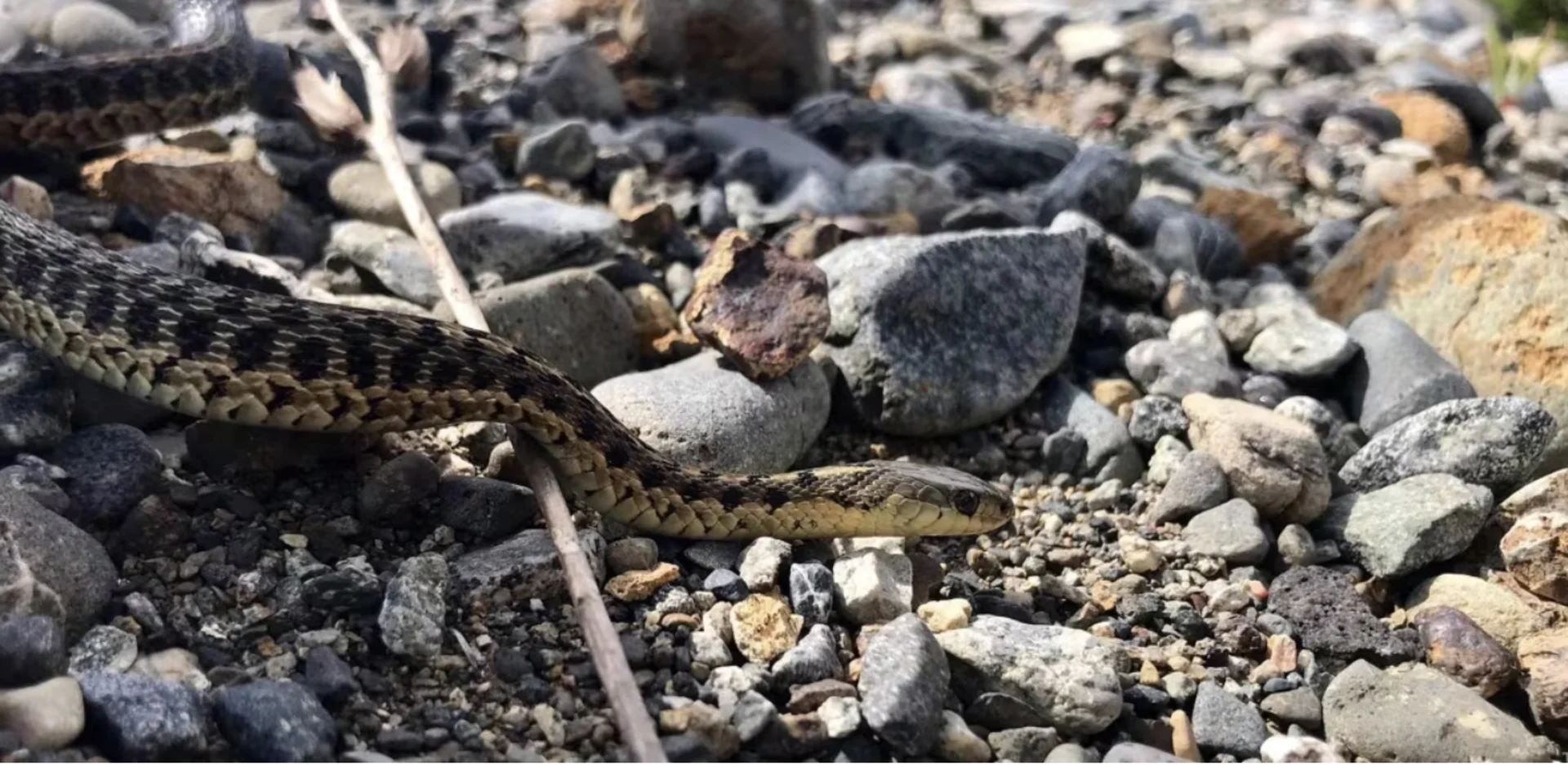
Contrary to popular belief, snakes do exist in this part of Canada

Andrea Gigeroff is a PhD researcher at Mount Allison University in New Brunswick. She is studying snakes in Newfoundland. (Submitted to CBC by Andrea Gigeroff)
If you catch a glimpse of something long and slinky on the ground in western Newfoundland this summer, it could indeed be just what you think it is.
Yes, that's right: there are snakes on the island, and they are breeding here.
Andrea Gigeroff, a PhD researcher from Mount Allison University who's back in Newfoundland for a second straight year, has seen dozens of garter snakes up close.
Snakes aren't native to the island, so her inquiries initially were met with surprise.
"A lot of the time, people looked at me like I had three heads," said Gigeroff. "A lot of people would say, 'There's no snakes in Newfoundland.'"
Contrary to that common belief, there are snakes in the region. The first confirmed report of a snake on the island was in 2010 in the St. David's area of Bay St. George South. Most of the reports since that time have come out of the same area, but there have also been garter snakes observed in other locations, including Trout River, Middle Arm, and on the east coast near St. John's.
RELATED: Here's where venomous snakes exist in Canada

This garter snake was located in the St. David's area of Bay St. George South. (Submitted to CBC by Andrea Gigeroff)
Seeing is believing
Tony Pottle of Stephenville had heard the stories but, even though he's an outdoorsman and a licensed guide, he'd never seen a snake for himself until last week.
Pottle was in an area near the mouth of Robinsons River when he saw what was unmistakably a snake move along the ground.
He wasn't quick enough to grab a photo of that first sighting. But he saw it again, or one like it, later that evening and took a video.
"It didn't pay much attention until I got really close, and then it sort of just scurried off the log, and then it disappeared into the long grass," said Pottle.

Tony Pottle recently saw a garter snake on this log near the Robinsons River. He captured the snake on video along with a panoramic view of the area in which it was found. (Submitted to CBC by Tony Pottle)
Pottle has seen photos of snakes shared in the past, often prompting comments from naysayers who don't believe the photos were taken in Newfoundland.
To ward off such negativity, on the same video that showed the snake, Pottle captured footage of his surrounding area, near Robinsons River.
"I've got proof. I made a panoramic view of the river basin in the video, so there's no question: The snakes are here," he said.
WATCH BELOW: If you are bit by a venomous snake, here's what you should actually do
Catching a (hay)ride
For every snake she's seen or been told about, Gigeroff has also encountered just as many doubters.
People in Newfoundland have lived for generations with the certainty that snakes had not made their way to the island.
But, for those who are believers, the working theory is that snakes were likely introduced accidentally, perhaps stowed away in hay bales imported by farmers as feed for their livestock.
One of the things Gigeroff hopes to learn from her research is how closely related garter snakes in Newfoundland are to those elsewhere in Atlantic Canada.
To accomplish that, Gigeroff is collecting snakes in Newfoundland and will take genetic samples to analyze and compare with snake DNA held in the zoological collection at the New Brunswick Museum.

This snake was found in Trout River. (Submitted to CBC by Julia Riley)
Belly buttons as proof
Wherever they've come from or how they got here, Gigeroff says what is certain is that snakes in Newfoundland are definitely breeding.
Gigeroff said, in fact, that first confirmed report back in 2010 was of a pregnant garter snake that was collected by the provincial government's wildlife division and had babies in captivity.
Some of the snakes Gigeroff has seen this year are very young.
"When they're really little, they have a little belly button where they connect to their egg sac, so you can tell that they're very new snakes to the world," said Gigeroff.

This garter snake was found in Trout River. (Submitted to CBC by Julia Riley)
Who's eating who
Gigeroff's research will include analyzing the stomach contents of the snakes she captures to discover what they are eating and to determine how the non-native reptile might be affecting other species.
"Garter snakes basically will eat anything that they can get into their mouth," said Gigeroff, who speculates they could be eating toads or green frogs.
More worrisome would be if the snakes are eating nestling birds or baby meadow voles.
Gigeroff said there are several species in particular that would be of concern if snakes are feeding on them, such as the rusty blackbird, barn swallow or olive-sided flycatcher.
"We want to make sure that they're not eating those, because that would be quite a problem," she said.

This garter snake was found in the Trout River area. (Submitted to CBC by Julia Riley)
This article, written by Bernice Hillier, was originally published for CBC News.